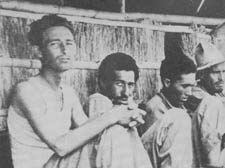
Allied prisoners in Cabantuan barracks in the Philippines |
Best of British whose nightmare is forgotten
Defeats are more interesting than victories, and none more so than the Allied collapse in the Far East, writes Martin Bell
PRISONERS OF THE JAPANESE
by Gavan Daws
Simon and Schuster, £18.99 order this book
AS a people, we tend to celebrate our victories and ignore our defeats, or (as with Dunkirk) romanticise them as something else. Historians do they same.
There are shelves full of biographies of Nelson and Wellington, and accounts of Trafalgar and Waterloo.
This is a pity. It upsets the balance of our understanding of history. Defeats are interesting, debacles even more so: and we have so much more to learn from them. I have always found failure more interesting than success.
It is a pleasure, therefore, to welcome Prisoners of the Japanese by Gavan Daws, a wide-ranging account of the consequences of the allied collapse in the Far East from 1941 to 1942, and of the experiences of some of the 320,000 prisoners, civilian and military, who fell into Japanese hands.
The victims of execution, brutality, starvation and disease, more than a quarter of them did not survive to be liberated in 1945. Those who did survive were saved by the atom bomb.
In Singapore a larger force surrendered to a smaller one in February 1942. The so-called fortress lacked proper landward defences. A series of allied blunders ceded control of the seas and the skies to the Japanese.
The 18th British Division had only just arrived. The Australian 27th Brigade collapsed before the Japanese onslaught. Their general ignominiously escaped by boat.
And so there occurred what Churchill described as the “the worst disaster and largest capitulation in British history. Our soldiers,” he lamented, “are not as good fighters as their fathers were.”
The story told by Gavan Daws is from a distinctly non-British perspective. He is excellent on the divisions among the allies and their mutual disrespect: “The Dutch pointed the finger at the British as the ones who rolled over first and most disgracefully, in the Malaya campaign.”
Daws himself points the finger at the British officer class, as indeed did many of the British other ranks, and still do to this day. His heroes are Australians and Americans, especially the men of the 131st Field Artillery of the Texas National Guard, taken prisoner on Java in March 1942 and held (like all of them) in the most appalling conditions for three-and-a half years.
For the Japanese themselves it was dishonourable, indeed unthinkable, to be taken prisoner, which is why so few of them were.
That was one reason for their treatment of prisoners as a sub-human species. Whether the prisoners lived or died was seen a matter of no importance, except for their utility as slave labour.
And across the whole of the Far East theatre, it was a war without rules. “The Japanese massacred when they were winning, and when they were threatened they massacred too.”
A useful companion to Prisoners of the Japanese, and in my view a corrective to its ingrained anti-Britishness, is Singapore Burning, by Colin Smith, formerly of the London Observer.
He provides a balanced, lucid account of the series of blunders and misfortunes that allowed the bicycle brigades of the Japanese to take Malaya by storm and roll into Singapore through its unguarded back door.
One reason for the debacle was an ingrained racism, what Daws calls “a disastrous white man’s miscalculation about the Japanese, a world-class mistake”.
They were regarded as inferior soldiers with inferior equipment, men smaller than their rifles, unable even to see very clearly, still less to fight in the dark. Yet in six months they had carried all before them from Malaya to the Marshall Islands.
In the words of Lt Gen Arthur Percival, who commanded the fallen garrison of Singapore, “Not all men are heroes, though the readers of military histories who have no practical experience may get that opinion.”
Now is the time for the story to be fully and properly told, while the last of the old soldiers are still alive.
I know many of them, in my capacity as President of the Japanese Labour Camp Survivors Association.
The youngest of them now is 82. They are really the best of British. They were not responsible for their commanders’ mistakes, although they suffered the consequences of them, and of their captors’ brutality, for three and a half dreadful years.
There has still been no formal apology from the Japanese government; and there was no show of appreciation from the British government, until the Prime Minister distinguished himself by agreeing, in November 2000, to a measure of compensation for the survivors.
All we can do, who live such easy and less remarkable lives, is to try to understand what they endured, and to salute their courage and indomitable spirit.
And in this respect I would like to thank the Camden New Journal for its consistent support in the cause of this band of heroes.
|








